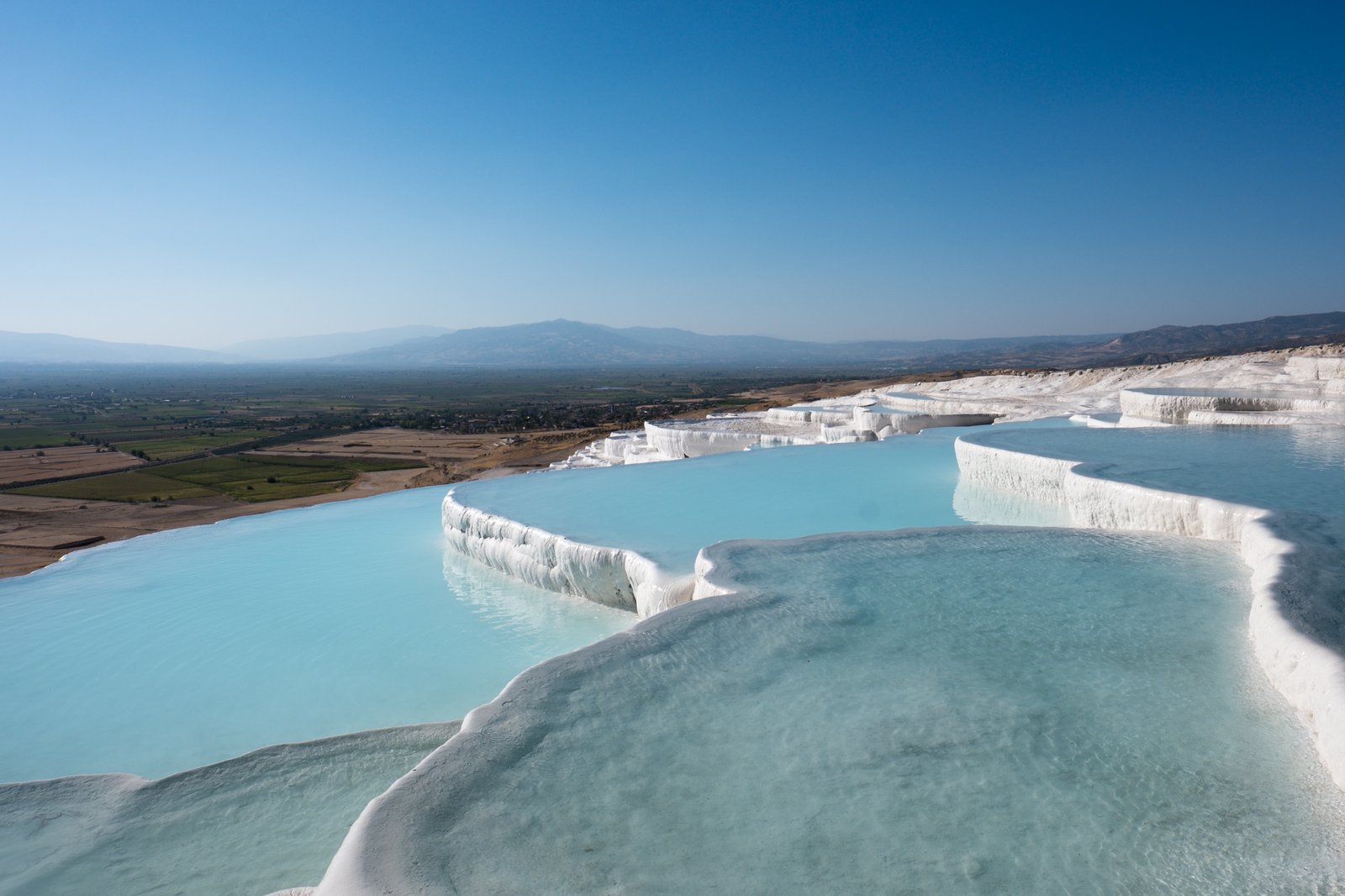Picture an out-of-place snowfield cascading down the calcite hillside overlooking the verdant farmland. An ancient Cotton Castle featuring pristine, white travertine terraces filled with powder-blue water. That’s Pamukkale.
Touted as Turkey’s one of most surreal panoramas, I can’t recall how many times we drove past Pamukkale before, but as the saying goes: better late than never, no? Uhmmm…Perhaps.
Throughout history, the calcium-rich hot springs of the region gradually fanned out to form the dazzling white-layered pools of Pamukkale down the slope.
Once overspilling with mineral-rich spring water, the travertine terraces of Pamukkale today resemble a rice terrace, likewise with a manually controlled irrigation system. The official claim is that the thermal water has been diverted to allow the terraces to recover from past mistreatment. However, whether the terraces will ever return to their former glory is doubtful.
As water no longer flows naturally through the travertines, the pools are not all with the spring water, most parts blackened. The scenery at this UNESCO World Heritage Site (inscribed in 1988) is far from ideal. Throughout the years, the population of the town has increased in great part due to tourism. Today virtually every single guesthouse in the region comes with thermal water on tap, let alone the huge spa resorts, draining the precious resources of one of the world’s greatest natural wonders.
Is Pamukkale worth visiting, you may ask? If you’ve seen Istanbul, Cappadocia, and Turkey’s Mediterranean coast, and if Pamukkale is on your way, then you may want to break up the journey to see the spectacle with your own eyes. But I wouldn’t make it the primary attraction of my trip, nor would fly halfway around the world just to see it. Chances are that you’ll leave disappointed at the end of the day. If you have the resources and want to see the place, by all means do so. Just be sure to set your expectations right.
As for me, eventually, in October 2021, it was time to check this world-famous place off my list, and I must admit the best time to visit Pamukkale was 30 years before. Sadly. In my humble opinion, today’s Pamukkale is merely a mediocre sight. With that being said, read on for invaluable tidbits about how to get the best out of your day.
All things time management
Aside from the fact that the best time to visit Pamukkale was at least three decades ago, April to June and September to October would be the ideal months for a trip. The summer months are extremely hot and busy, and in winter it might even snow.
A total of 4-5 hours would be more than enough to cover the entire site, hitting all the main attractions in Pamukkale, namely the travertines, Hierapolis ancient city, and Cleopatra’s Pool (allot two hours for swimming if you fancy).
You should enter either right at the opening time to catch fewer crowds or in the evening to watch the sunset. In either case, be sure to allow plenty of daylight time to see the true colors of the travertines.
All things logistics
Where to Stay
As half a day would suffice to visit Pamukkale, you don’t necessarily need to stay overnight, especially if you are traveling by car. However, if you are relying on public transportation, chances are that you’ll want to spend the night before or after visiting Pamukkale.
Pamukkale town is the closest to the same-named world wonder. The tourist-infested town has no charm whatsoever. You’ll find a range of accommodation and food options, usually at an inflated price tag.
The village of Karahayit lies only five kilometers from Pamukkale travertines and is popular with local tourists. The rates around here are more reasonable than in Pamukkale, and I found the ambiance of the village pretty authentic. In my opinion, staying overnight in Karahayit is a better option than staying in Pamukkale town itself.
Denizli is the capital city of the province, and as such, it has a broad range of accommodation and food options. The minibusses to Pamukkale/Karahayit depart from the Denizli Bus Terminal, platform #76 (you need to take the escalator down to the subterranean level). The easy-peasy journey takes about 20 minutes.
Entrance Gates at Pamukkale
West Entrance is the one in Pamukkale town itself, at the base of the hill. The public minibus would drop you off at this entrance by default. When you stand at the base of the hill, note the perfect symmetry of the half-circular artificial pools built along the cliffside to hide the damage caused.
 |
 |
This entrance allows you to walk up (or down) the public travertine pools to reach the Hierapolis ancient site on the summit. This terrace ridge is the only section that you can walk on, and you are only allowed onto the travertines barefoot.
South Gate is the closest one to the main area where travertines, ancient theater, museum, and Cleopatra’s Pool are located. This gate is not accessible by public transport, and tour buses will drop off their guests here.
The north gate has parking spaces, and public transport can drop you off at this entrance as well. This gate is the furthest away but will take through the Hierapolis’ northern necropolis among other ruins, along a 2 km trail. If you don’t feel like walking, you can jump on a golf cart that will bring you to the main area for an additional fee. As it’s one of the ancient site’s quieter areas, it’s a good place to either start or end your visit.
Long story short, the best way to experience the Travertines and Hierapolis Ancient City is to enter from the north and exit from the west or vice versa. As we approached the site from Karahayit, we entered from the north. So, follow me this way.
All things to do
1. Wander through the ruins of the Ancient City of Hierapolis
The remnants of a grand colonnaded street will take you from the necropolis in the north to the Byzantine church at the south end, among various temples, agora, gymnasium, and monuments. The ancient ruins of the Greco-Roman spa town Hierapolis dating back to the 2nd century B.C. hold legends and tales. If you are a history buff, you are in heaven, though the uninitiated may just see yet another stone.
I’m not going to bore you with historical details, but rest assured the city will come to life as soon as you see the impressive and well-preserved ancient theater with its sweeping views across the countryside.
2. Skip Cleopatra’s Pool
Pamukkale’s Antique Pool is claimed to be the most atmospheric hot spring experience you’ll ever have, with half-submerged columns and chunks of fallen ancient stones scattered in the water all around you. The claim may hold true if it were possible to ignore the sunburnt tourist crowds, and a heavily commercialized food court playing Macarena over the loudspeakers right next to the pool. To add insult to injury, there is an extra $10 USD on top of the entrance fee. Given the circumstances, you may wish to forego the pleasure of taking a dip in the antique pool. It’s free to walk around the perimeter.
3. Visit Hieropolis Museum
This small but excellent museum sits in front of the antique pool complex and is definitely worth a visit. The cultural heritage of this once-important city is on exhibit inside a former Roman bathhouse, where some of the most ornate sarcophagi can be seen.
 |
 |
 |
4. Walk along the travertine pathways
A wooden walkway winds along the top edge of the travertines. From here you can get panoramic photos of the travertine pools and the countryside beyond.
It’s worth mentioning that you can soar over the Pamukkale travertines on a hot air balloon, microlight, or a tandem paraglide (though Cappadocia is hands-down the best place to fly high).
5. Soak in the Red Springs of Karahayit
Given the proximity of the Karahayit to Pamukkale travertines, it’s a no-brainer that the village bubbles up with mineral-rich hot springs. The water around here is rich in various oxides, including iron oxide, thus the calcium carbonate of the springs is tinged with a variety of colors.
Even if you don’t stay overnight in Karahayit, you may want to stroll through the village market, enjoy a cup of tea or coffee, and soak in the bathing pools to soothe weary travel muscles for an hour or two.
6. Keep an eye out for the Denizli Horoz (Rooster)
Did you know that the city of Denizli is obsessed with roosters? Yep, “Denizli Rooster” is the symbol of Denizli, a domestic breed well-known for its color, body shape, and its long and harmoniously beautiful crowing.
 |
 |
Apart from the famous glass statue in the city center (picture on the left above), the newest addition to the collection is a giant 27 meters tall statue at the scenic lookout (Seyir Tepesi) that opened in 2020.
 |
 |
BONUS: Explore the miniature Pamukkale hidden underground in Kaklik Cave
If you have come this far and have come to the conclusion to visit Pamukkale, then you MUST absolutely make sure to see this hidden gem of a kind! It’s such a stunning place that it snatched its dedicated blog post (click here)!



















Thank you so much for helping me have realistic expectations and to discover other lovely places around here to see! Just got back. Thanks again!!!
Thank you for your feedback, glad to hear that I could help you 🙂 I hope you had a fantastic time. Happy travels!
[…] the interwebs planning a trip to Pamukkale renowned for its travertines. If you’ve read my realist guide to Pamukkale, you must, latest by now, be aware that the experience with a high probability won’t […]